This is the second article in a series aimed at helping new shooters become comfortable with the idea of not only engaging people in the shooting community, but also taking the first step into that community and participating in all it has to offer. If you are a seasoned veteran of the shooting world, please pass this along to someone you’ve been encouraging to get to the range or someone you think could benefit from it. (Thanks!)
After reading Part 1, you should be ready to start planning your first trip to the range. Huge disclaimer: I am not a gun expert nor am I suggesting this is the only available information on how to approach your first trip to the shooting range. The intention is to share my experiences and what I’ve learned from them in order to make your first trip a more positive one than if you just showed up without any background knowledge.
This article is meant to be used as a sort of checklist. You can print it, take it to the range, and walk through your first range experience with confidence. Each range is a little different, so if a step doesn’t fit your particular situation, skip it and move on to the next. There really isn’t a “one size fits all” formula for this, but it should accommodate most situations.
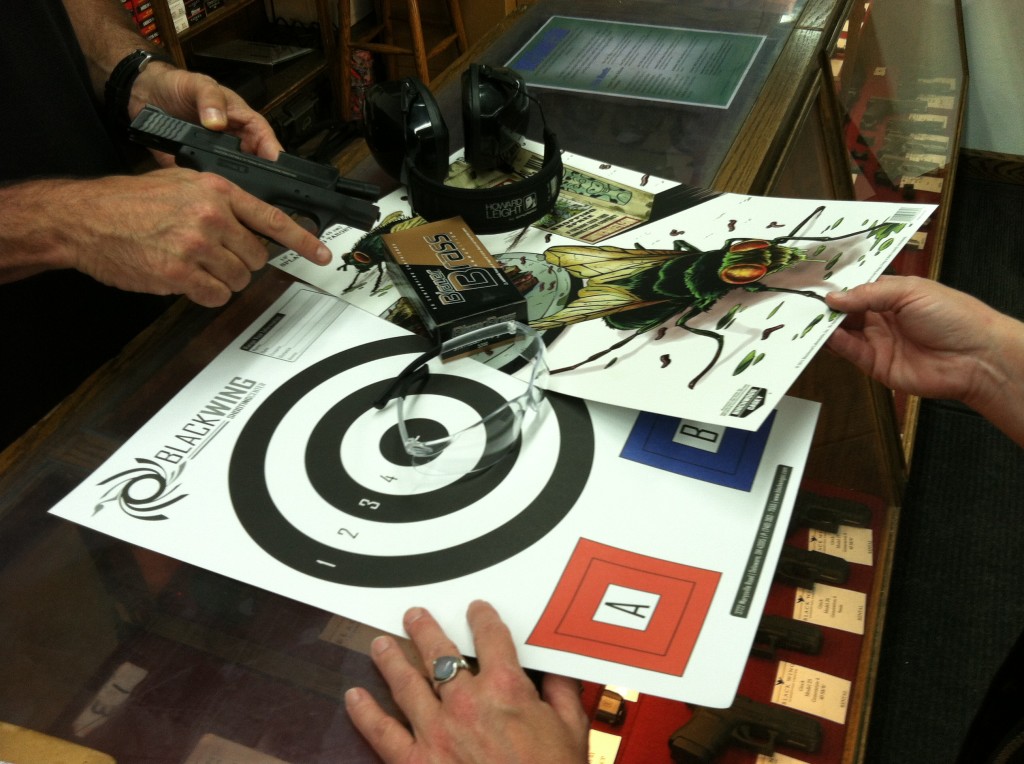
Rental and purchase of all items — lane, targets, ammo, firearm, eye and ear protection — can be done together as opposed to separate transactions. Photo: author
Indoor Versus Outdoor Range
If you own a limited amount of gear, you may want to consider going to an indoor range for your first time. Indoor ranges usually provide a wider variety of items for rent or purchase, such as eye and ear protection, targets, ammo, and even gun rentals. After doing a little research, I found that most outdoor ranges have targets, eye/ear protection and some ammo, but fail to provide firearms rentals. Most indoor ranges offer everything in some capacity. Choosing an indoor range over an outdoor one for your first shooting excursion is just a suggestion. But going to a facility that provides multiple rental options for firearms, ammo, targets and eye/ear protection would certainly help the experience be a positive one.
The Checklist
1. Call the shooting range or visit their website to get an idea of:
a. Hours of operation.
b. Do they offer private instruction?
c. Do they rent guns and eye and ear protection?
d. Can you buy ammo and targets?
e. How many people can share a lane at one time?
f. Do they rent lanes by the hour or for an unspecified period of time?
g. Do they have leagues or member-specific days that would make certain days busier than others?
2. Allow enough time so you don’t feel rushed at the range.
a. Don’t walk in during the last hour prior to closing. Think how you feel in the last hour of your work day. Got the picture? Okay, then.
b. Try not to “squeeze it into” your schedule. Take enough time (a couple of hours) at the range so you aren’t distracted by the thought of having to rush to the next event of the day. Remember, you’re trying to learn something new. Set yourself up for success.
3. Get a designated bag for range items. If you already have some shooting equipment or have borrowed some from a friend, put it all in one bag for the range. Being tactical with your bag isn’t a prerequisite. A small- to medium-sized tote with multiple compartments will work just fine. If you like the shooting experience, you’ll have plenty of opportunities to find that perfect range bag.
Here’s how I carry “stuff” in my bag:
a. Firearm(s): unloaded, magazine out, slide in a locked open position.
b. Hearing protection (mine are still the big puffy ones).
c. Eye protection.
d. Ammo (if you are bringing your own): put it in a separate pocket from the firearm. Show it to the range officer or person signing you up for the lane to make sure it’s not a type of ammo they do not allow on their range.
e. First-aid kit: Don’t freak. But a small, effective first-aid kit is a good idea for even the most basic slip-up on the range. Better safe than sorry!
f. Gun cleaning kit: If you have one. Otherwise, no big deal.
4. Schedule private instruction or meet a friend with firearms knowledge and training. This can be as detailed or as basic as you like. But there are a few elements you must know before heading onto the range:
a. At the very least, be able to properly handle a firearm (know how to pick up the firearm, how to hold it, where to place your trigger finger when you are not ready to shoot, etc.).
b. Know how to properly load and unload your magazine and insert the magazine into the firearm.
c. Know an effective way to position your body while shooting, including stance, arm position, and head position.
5. When you get to the shooting range, locate the range counter. Ask if there is a wait for a lane. If so, you may have time to browse the other items in the store. If there isn’t a wait, go ahead and start the process of signing up for a shooting lane.
6. If you didn’t bring any of your own firearms, choose a couple of rental guns to try (key elements in choosing a firearm will be in a subsequent article) if they are available at the range.
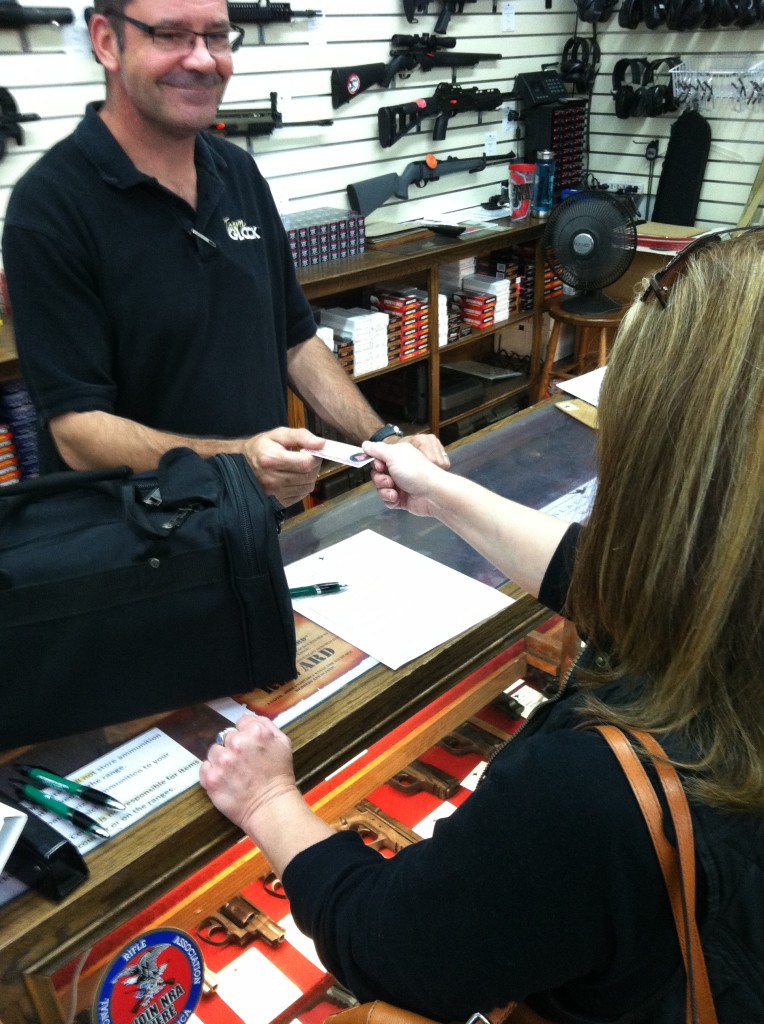
A photo ID and signed liability waiver are required to rent space on a shooting range. Photo: author
7. Have a photo I.D. handy. Most ranges hold your lane with a photo I.D. and signed waiver of liability form.
8. Sign the waiver of liability form.
9. Locate the range officer so you are aware who it is in the event you need them quickly (or at all).
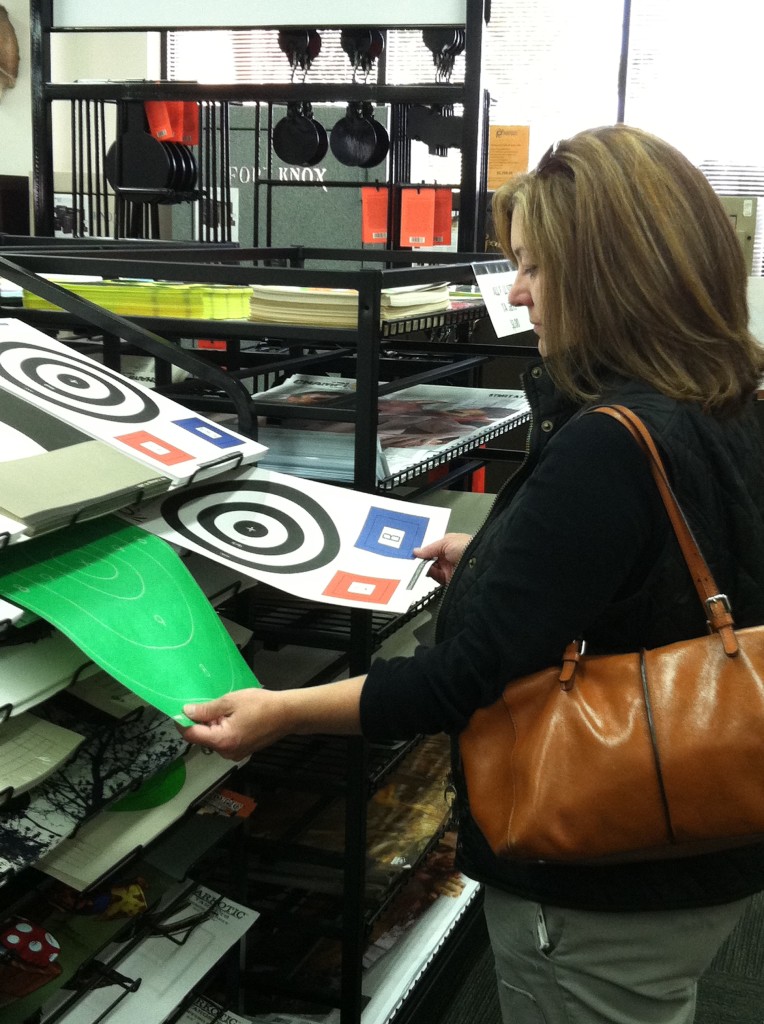
Choose a variety of targets in order to check for accuracy and also have a little fun. Photo: author
10. Choose a few different targets. “Vanilla” targets (bulls-eye or silhouette targets) are good to begin with to give you a feel for shooting your firearm and checking accuracy. But choose a different one as well; maybe something fun. Sometimes a range will have zombie targets, splatter targets (a neon outline of your shot on the target), or miscellaneous fun targets.
11. Pay for everything (targets, ammo, gear rental, lane rental).
12. When your lane is ready, you’ll be asked to place your eyes and ears on before you enter the range. If it’s a two-door system to enter the range, open the first door and let it close completely before opening the second door that is directly attached to the range.
13. Get out there and practice what you’ve learned. This is going to feel weird, for sure. But don’t sweat it. You’ve received the basic training, you’ve got basic protective gear, the range officer is within reach (hopefully), so go ahead and practice. A healthy dose of nervousness is fine as long as it doesn’t hinder you from trying out what you’ve learned. Now that you’re inside the range itself, here are some procedures to help you set up shop in your lane:
a. Put your range bag with your firearms and ammo on the bench in the shooting lane, and place the firearms and ammo directly on the bench with the firearm barrel(s) pointing downrange.
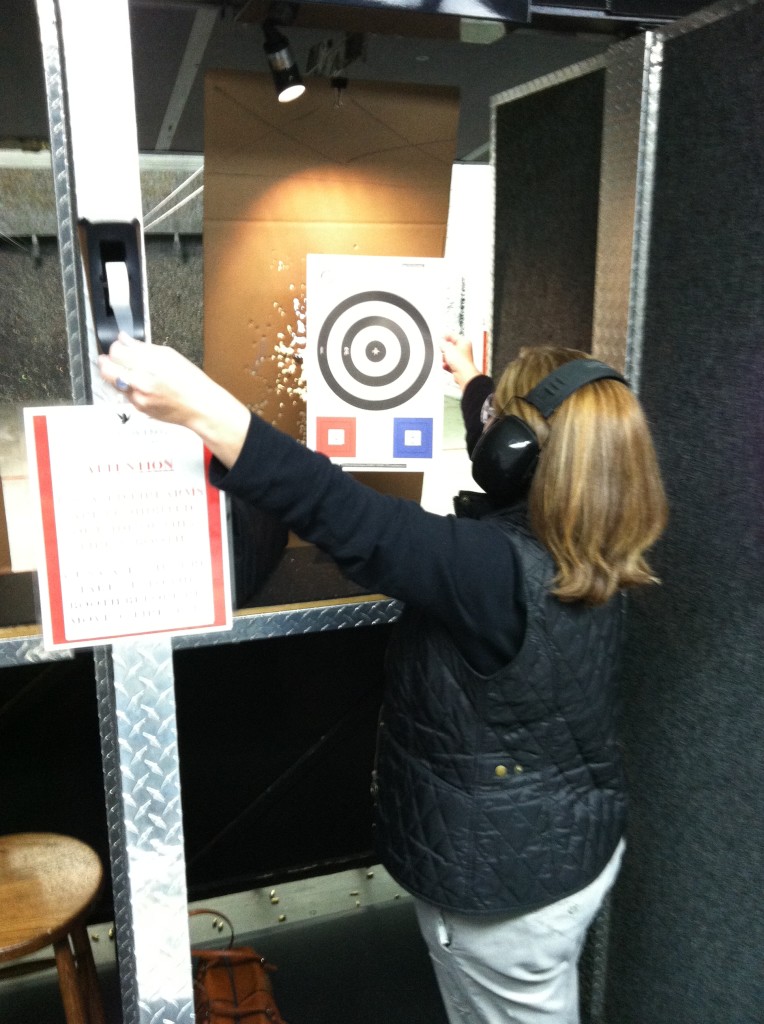
Process of hanging targets can vary from range to range, but most keep it pretty simple. Photo: author
b. Hang your target. This should be pretty basic. There’s probably a pulley system of sorts that allows the target to be moved closer and farther away from you. There might be clips or tape to attach the paper target you purchased to that pulley system (probably electric). All of this should be shown to you by the range safety officer. If not, and you are unsure, ask. They won’t bite!
c. Load ammo into your magazine in your shooting lane, for now. Some ranges are okay with you taking the magazine and ammo (not the firearm itself) away from that “safe zone” area (the bench in your lane), but just to keep things simple, do it all right there in your lane.
d. When in doubt about anything, put the firearm down on the bench in your lane with the barrel pointing downrange and look for the range officer. The main hazard they are looking for is unsafe handling of the firearm that would jeopardize you or another person on the range. If the firearm is out of your hands pointing downrange, you’re good. Ask your question and get back to shooting.
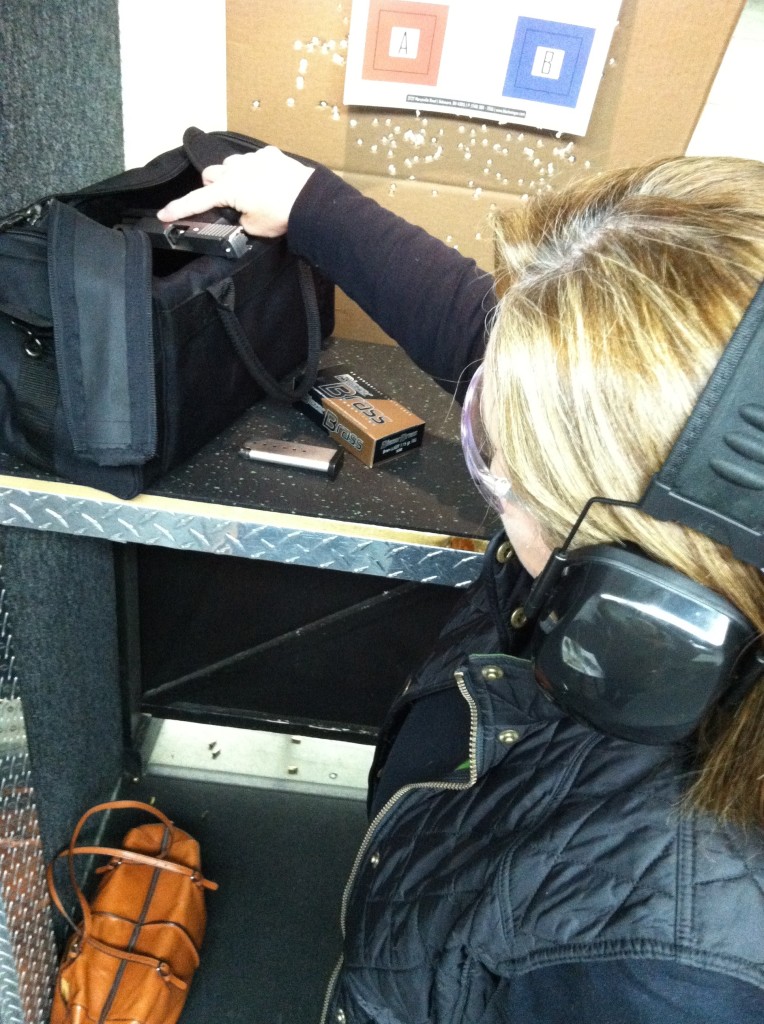
Load and unload your range bag inside your lane on your bench, pointing all firearms downrange. Photo: author
15. Return all rented items to the range counter and get your I.D. back from the range counter staff.
16. High five your range buds if you came with a group, tuck all your firearms away at home (if you brought your own), and head out to your local pour establishment for a beverage. You’ve earned it!
I hope you find these steps helpful. Each shooting range is different, and you may have to modify slightly to fit your particular situation. But for the most part, it’s pretty much as stated above. You’re probably a little nervous because this is something new. But go ahead and get the first trip under your belt, and I guarantee you’ll feel much better.
Rate the Range
Finally, I’ve created a link to a document called “Rate the Range.” This is a way to provide constructive feedback to the range you visited in order for them to make the new shooter experience as awesome as possible. Before heading to the range, print off two Rate the Range documents, fill them out right after your shooting experience, hand one to the manager of the range, and email one to me (julie@midohioimb.com). We just might be able to make a difference for another new shooter and help out a few shooting ranges as well!
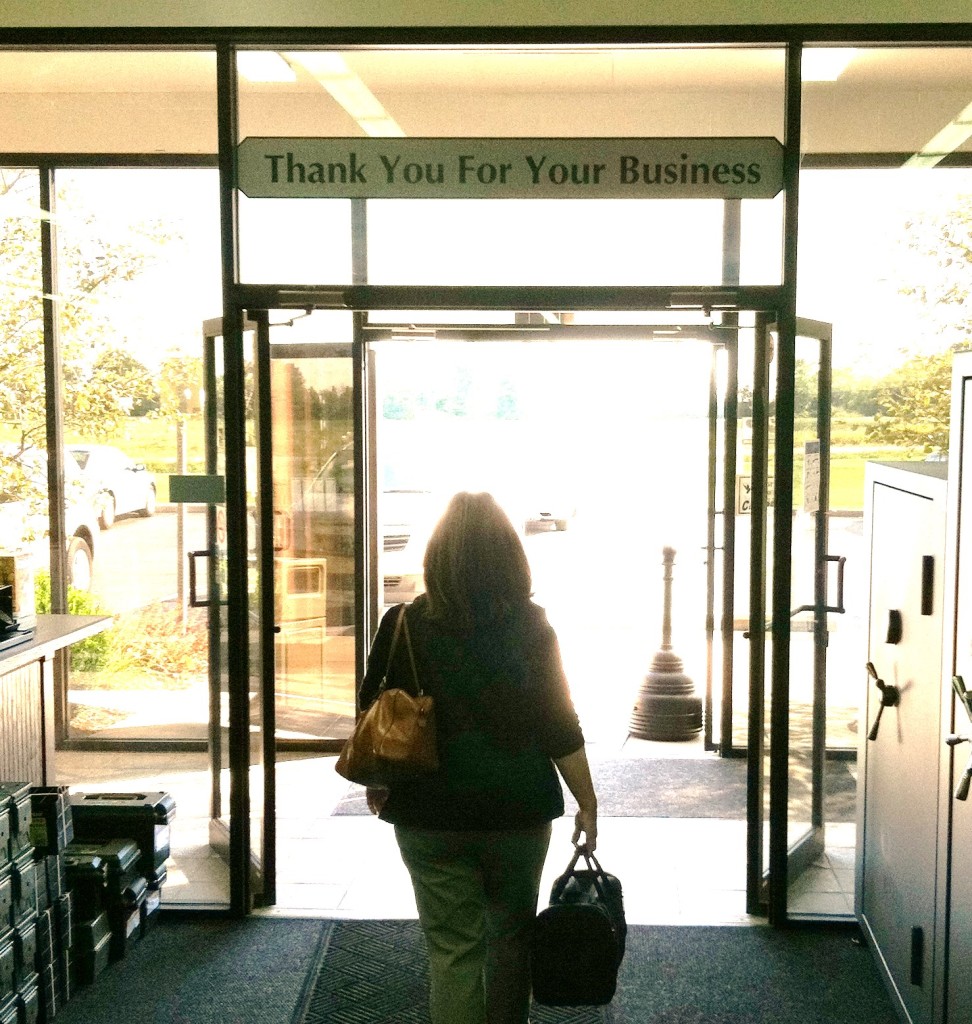
Kudos for the most complete list possible. I will add some different thoughts for beginner ‘shooters’ before the range. Col Jeff Cooper’s book “Principles Of Personal Defense” addresses the critical issue if a person is ready or capable of taking another persons life when the SHTF. This and other books and the Internet get into the nitty gritty of a very complex and detailed skill that requires total mental and physical attention. Holes in paper OK - but it’s not Kansas out there, Dorothy!
Wear a closed top shirt. Took my wife for first time and had hot shells flying down shirt.
Regarding the picture that says "Load and unload your range bag inside your lane on your bench, pointing all firearms downrange." The firearm is certainly NOT pointed downrange!!
I would like more information
Part 1 and 2 are both great articles; it is very helpful for the first-timer heading out to the range or gun shop to have an idea what to expect. I wasn't brave enough, so my boyfriend more than willingly accompanied me my first time out. People have been very friendly at the ranges I've visited and I've brought friends and family along with me to join in the fun! The first item on Julie's list is a MUST DO for anyone heading to a range for the first time. I had taken an NRA shotgun class at my local PBA range and called ahead prior to venturing there on my own a few days later. I was so glad I called as they only allowed SG use for LEO's or during their NRA courses. I strongly recommend renting a firearm or using a friends prior to making a direct purchase. Research and extensive reading is all well and good, but you won't know if you can handle the recoil from those books. I believe that I could not handle the recoil of a .45 ACP even after having several women tell me I could. I tried a few different variations and found I could handle it after all. Not all gun shops are created equal. It is definitely the quality of the personnel working there that make or break the shop. Don't let a few stuck-up store clerks, and the ones that are snotty are just that - store clerks, don't let them deter you. As Julie said, find another store. Sometimes, going back to the "stuck-up store" isn't such a bad idea. You might get a different person and real genuine service.